Quick search
CTRL+K
Quick search
CTRL+K

Abu Dhabi is the capital of the United Arab Emirates and beautifully located on the coast along the Persian Gulf. The city is characterized by the opportunities that come from the country’s huge oil revenues, and the many modern buildings, museums and activities can do nothing but impress tourists.
Abu Dhabi is a city where ancient culture meets the modern world. From the cultural Heritage Village, where the time has gone back to life before the oil economy, you can see the city’s skyline and majestic skyscrapers as a contrast.
In Abu Dhabi, there are great sights within the arts, culture and entertainment. The Emirates has successfully established international collaborations and, among other things, established Louvre Abi Dhabi, Warner Bros World and Ferrari World as major attractions.
There are several museums, and among the city’s other cultural sights stands the 18th-century fortress of al Hosn and the colossal mosque, the Grand Mosque, built with distinguished design and exquisite materials. And then the many shopping malls and tasty dining options in the city form another part of modern daily life in Abu Dhabi.
Abu Dhabi is centrally located in the United Arab Emirates and there are several excursions to enjoy from the city. The Emirates’ largest city, Dubai, is a short drive from Abu Dhabi, and a trip to the oasis city of Al Ain or along the beautiful beaches of the Emirate of Fujairah are also unforgettable and within relatively short driving distances.
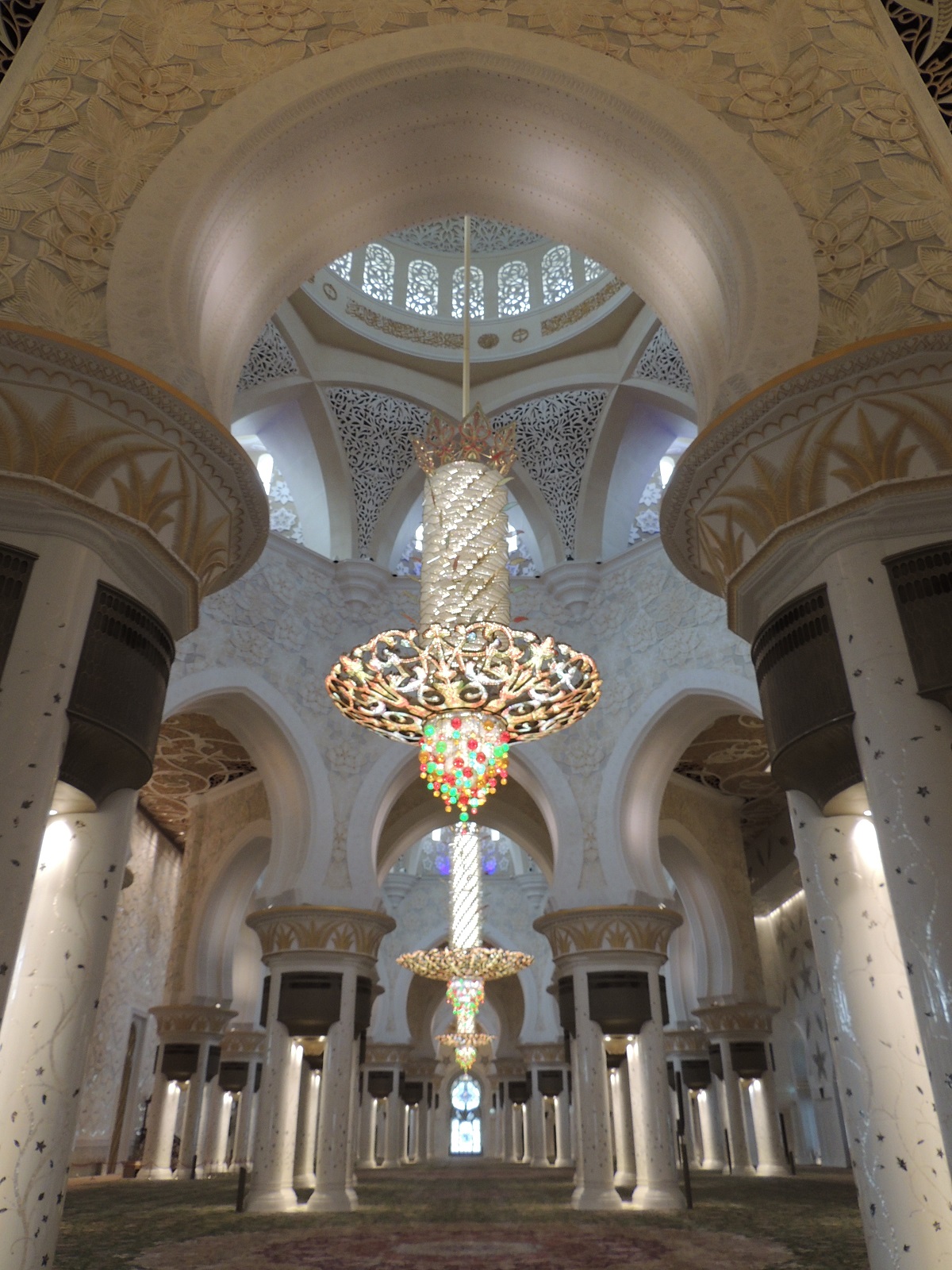
Sheikh Zayed Grand Mosque is Abu Dhabi’s grand mosque, built in the years 1996-2007. The large structure was designed by the Syrian architect Yousef Abdelki, and the dimensions are large. The complex occupies more than 12 hectares with a size of approximately 290×420 meters.
The project was launched by President Sheikh Zayed bin Sultan Al Nahyan, who wanted a work that would unite the cultural diversity of the Islamic world with the historical and modern values of architecture and art. And that was also the result.
The mosque was opened as the largest in the country, and on a visit you can immediately sense the colossal dimensions of the impressive building. The architect drew inspiration from, among other things, the Abu al-Abbas al-Mursi Mosque in Alexandria, the Badshahi Mosque in Lahore and other places with Persian and Indo-Islamic architecture.
The Sheikh Zayed Grand Mosque was built to accommodate 40,000 worshippers, of which there is room for 7,000 in the main prayer hall. There are four 107 meter high minarets which enclose the inner courtyard of the mosque, which is covered with a large and beautifully designed marble mosaic. There is also marble in the main prayer hall, just as there is stunning decoration throughout the facility.
During a visit, you start by moving into the facility, and from here there is a good and beautiful tour where you get around large parts of the mosque and its individual parts. It is a beautiful experience when you walk between the pillars and in the courtyard, where you can really see the architecture of the mosque.
The interior is also very beautifully decorated. Here you can see, among other things, the great mosque’s seven chandeliers from the company Faustig in Munich. They contain millions of Swarovski crystals. You can also see inlaid mother-of-pearl in marble, calligraphy and the 35-tonne carpet in the main hall, which was designed by Iranian Ali Khaliqi.
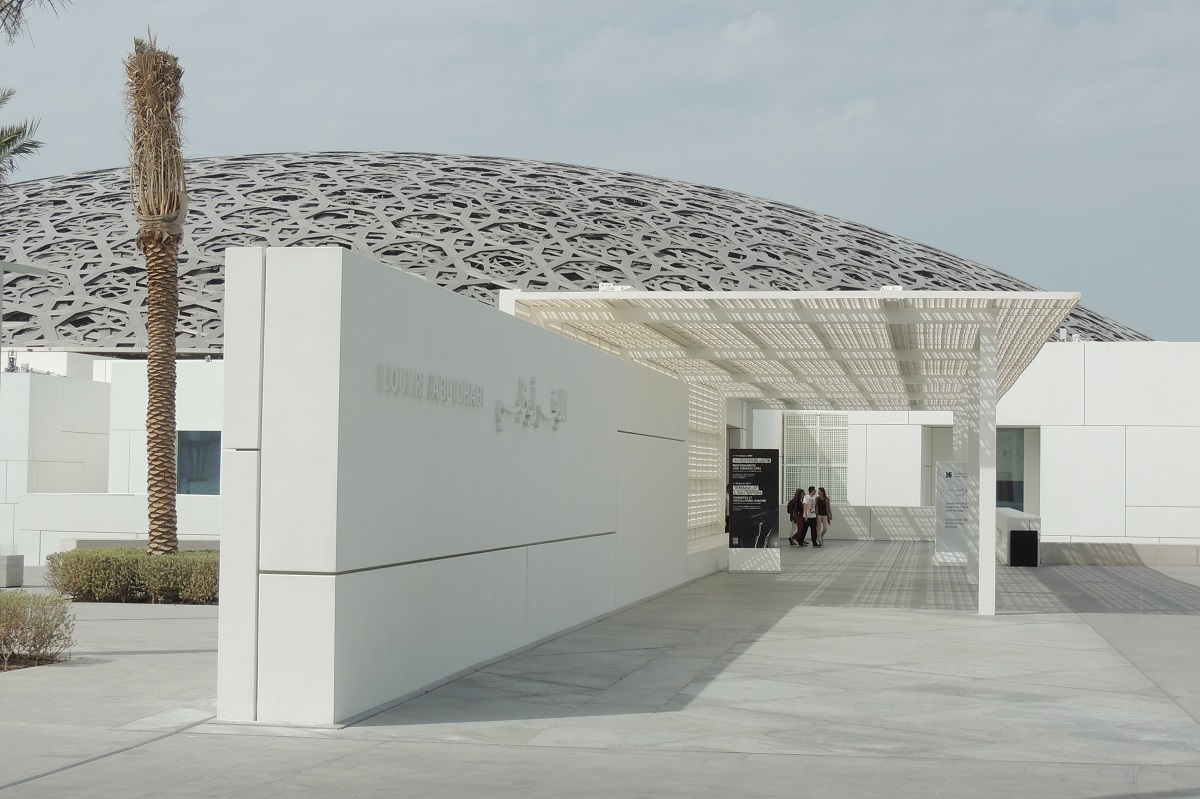
Louvre Abu Dhabi is an art museum that has been established by agreement with the French government. The museum was opened in 2017 in the cultural district on the island of Saadiyat Island, and the museum building was designed by the French architect Jean Nouvel with inspiration from, among other things, the sun’s rays through the palm trees in an oasis.
The museum opened as the largest art museum on the Arabian Peninsula, and it did so with a focus on exhibiting works that straddle Eastern and Western art. At the museum you can experience some fine exhibitions from the Louvre Abu Dhabi’s collections, and changing exhibitions are also arranged.
The idea for the museum was put forward by the United Arab Emirates in 2005 to the French government. After negotiations, an agreement was reached on the major cultural project in 2007. Work on the new facility started in 2009, while the museum itself was built from 2013.
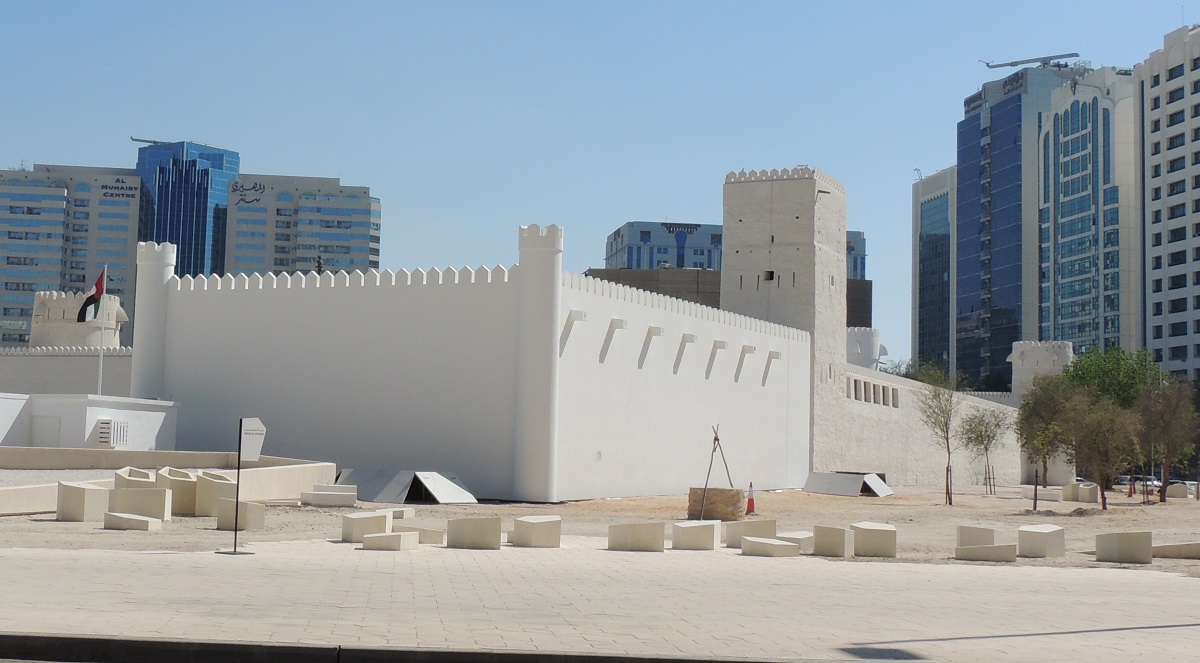
Qasr al-Hosn is one of Abu Dhabi’s most exciting buildings. The Al Hosn Fort was built in the latter half of the 18th century and is the oldest building in Abu Dhabi. For many years the building complex was like a desert fort, and it was surrounded by sand.
It was Mohammed Al Bastaki who designed the fort, which was built in 1761. At the time, it was a watchtower to monitor the only source of fresh water in the area. In 1793, the tower was expanded into a fort during the reign of Shakhbut bin Dhiyab Al Nahyan.
However, it was not until the 1930s that the fort got its current appearance. It was significantly expanded using revenue from Abu Dhabi’s first oil license and served as the residence and government palace of the ruling sheikh. The name Qasr al-Hosn also means the palace fort.
Today, Qasr al-Hosn is set up as a museum that displays objects and images depicting the country’s history. There are also various thematic exhibitions, and of course you can also experience the interesting fort during a visit.
Qasr Al Watan is the name of the presidential palace in the United Arab Emirates. It was completed in 2017 with a facade of white granite and limestone. The palace has a central dome with a diameter of 37 meters above the great hall of the palace, which is surrounded by two wings to the east and west.
The palace was initially only used for official events, but since 2019 it has been open to visitors. The palace is an impressive building, and on a visit you can see various exhibitions of, among other things, official gifts from other countries and the interior of the palace.
Mangrove Marine National Park is a wonderful opportunity for recreation in nature in a location almost in the middle of Abu Dhabi. The national park is a mangrove area that stands as a peaceful contrast to Abu Dhabi’s modern high-rises.
The mangrove forest makes up almost 75 percent of the total mangrove area in the emirates. You can visit the area in a kayak or on a boat trip and enjoy the biodiversity on the waterways of the mangrove forest, where you can see flamingos, herons, turtles and other animals, among other things.
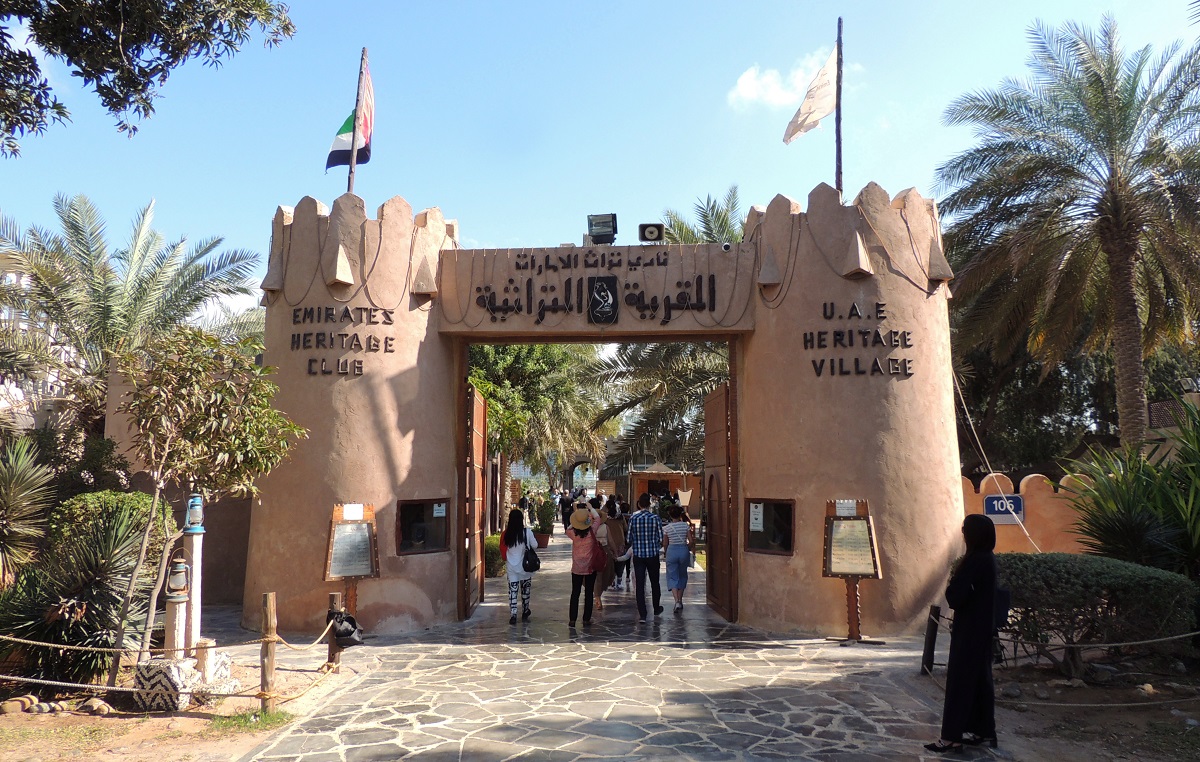
Heritage Village is a reconstructed city in Abu Dhabi, located as an open-air museum, where you get a good impression of the time before the United Arab Emirates’ oil revenues changed the country to what you can see today. It is a unique opportunity in the emirates, which otherwise stand as modern cities after a colossal development in a few decades.
You can thus experience the traditional lifestyle in the desert in the Heritage Village, where you can visit, among other things, an old-fashioned souk, a mosque and a camp modeled after the historical life of the country. There are also working workshops with artisans making ceramics, blowing glass and weaving fabric.
Emirates Palace is the name of a five-star hotel in a particularly beautiful location, which is one of Abu Dhabi’s best-known buildings. The hotel was built in the years 2001-2005 and it opened with 394 rooms and suites.
The luxury hotel is situated like a sumptuous castle next to the Persian Gulf. The hotel’s design blends Islamic architectural elements such as balance and geometry with modern design and construction. The hotel’s color is inspired by the desert sands of the state, and around it are beautiful green plants.
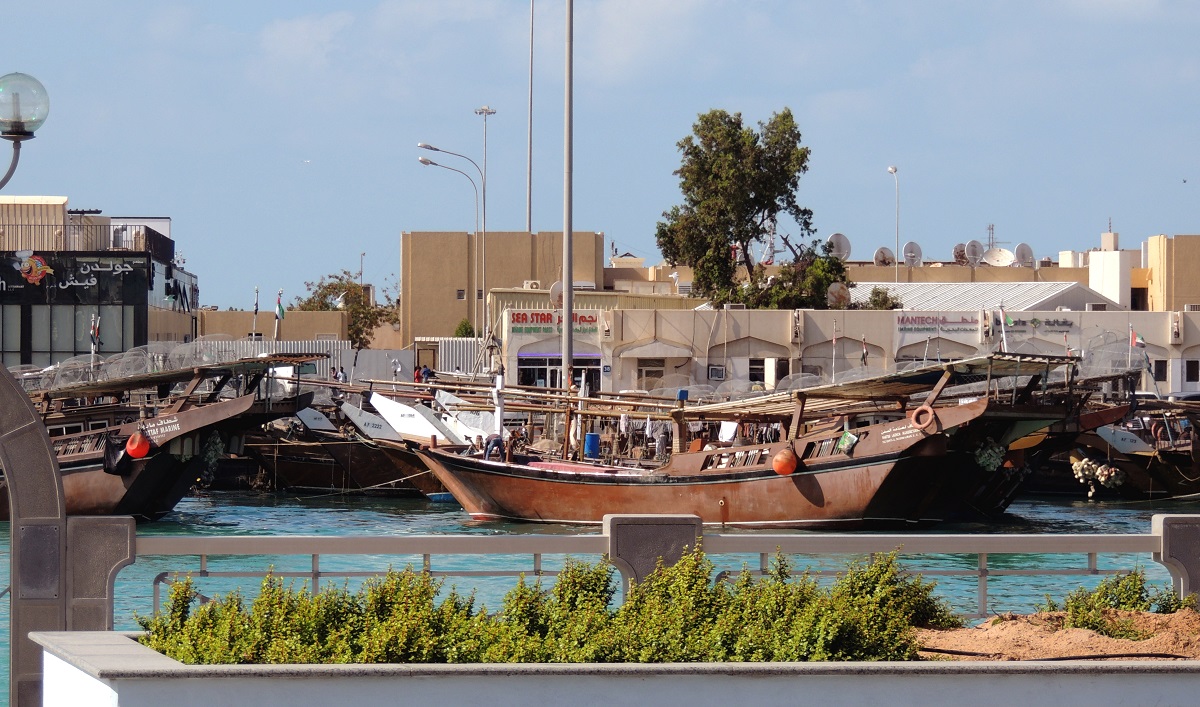
Dhow Harbour & Fish Market is an atmospheric place in Abu Dhabi’s harbor area. Here you will find, among other things, Dhow Harbour, which is home to many of the traditional dhow boats that have plied the waters along the current emirates and large parts of the region for centuries.
Today, the harbor is a lively fishing harbor where you can see and experience the atmosphere, and you can also visit the Fish Market, which is both a fish market and a place with many places to eat. Here you can have fresh fish prepared and enjoy it at the many traders’ eateries.
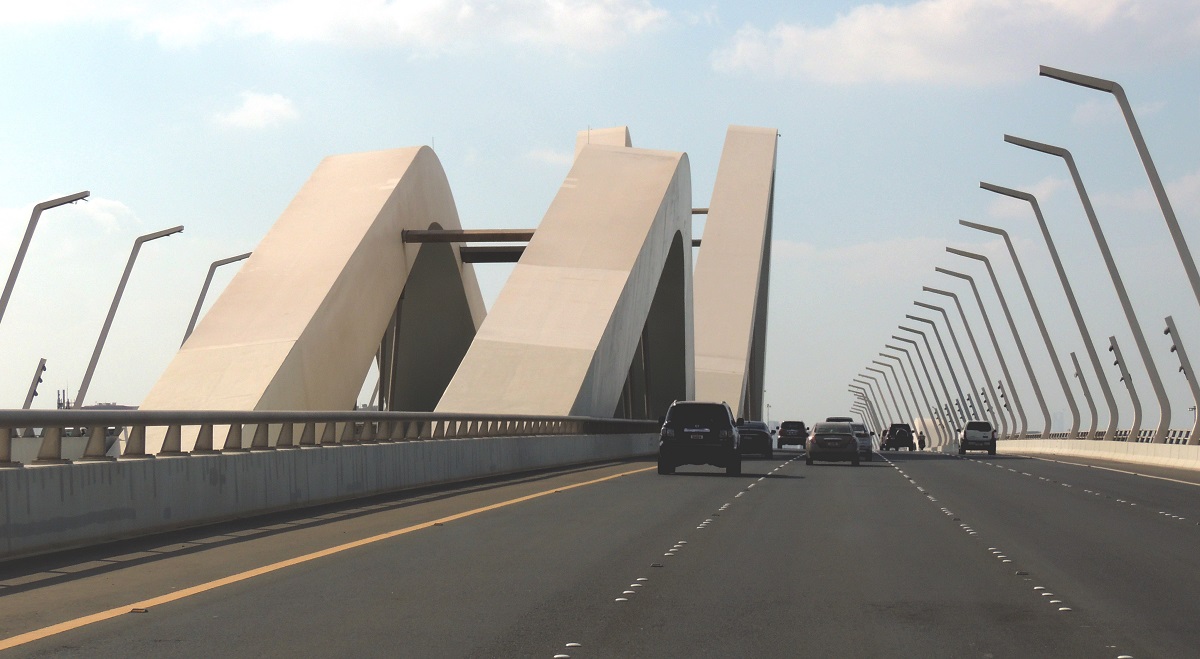
Sheikh Zayed Bridge is a bridge that is often passed in Abu Dhabi. The city center is on an island, and many other parts of the city’s neighborhoods are on other islands. Therefore, it is natural that there are many bridges here.
Probably the most noteworthy of the bridges to and from Abu Dhabi is the Sheikh Zayed Bridge, which was designed by the British architect Zaha Hadid. The 842 meter long and 64 meter high bridge is shaped like rolling dunes with a dynamic lighting design with subtle floating colours.
Ferrari World is a primarily indoor theme park in Abu Dhabi, and it is the first in the world with a Ferrari theme. And the theme is pervasive in many of the attractions you can experience under the red Ferrari roof that covers the place.
Construction started in 2007, and Ferrari World opened in 2010. Since then, several new rides have been established, and perhaps the best known is Formula Rosso. Formula Rosso is a roller coaster with a length of over two kilometers and a top speed of 240 km/h.
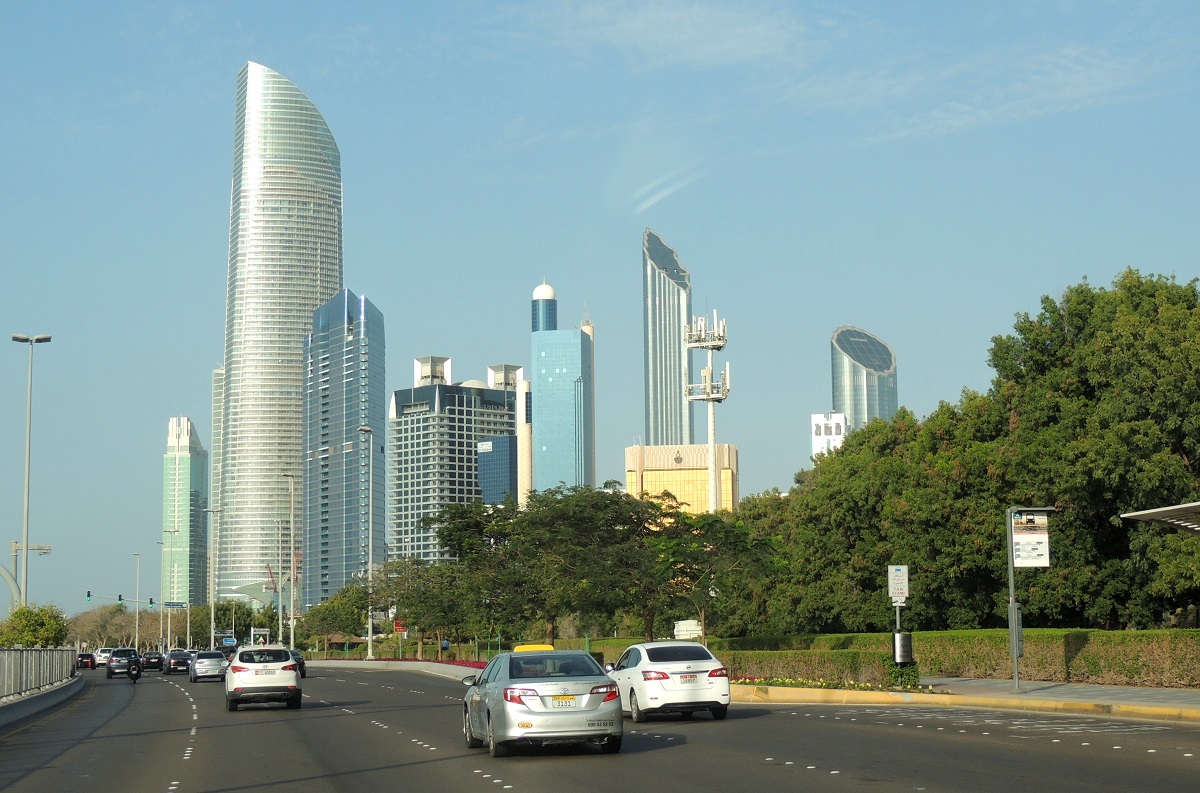
Corniche Road or simply The Corniche is an approximately eight kilometer long road in Abu Dhabi that lies breathtakingly along the Persian Gulf. The stretch is a popular place for a stroll, a bike ride or to go to the beach or use the playgrounds along the way.
The Corniche was built on reclaimed land, and decades ago there were sandy beaches here and dhows anchored and brought goods to and from shore. It is history, and today Corniche Road is a fashionable street with fantastic views over the water.
The UAE Flagpole is a 122 meter high flagpole that can be seen in many places in Abu Dhabi. It is a flagpole that was erected as the world’s tallest in 2001 near the Marina Mall.
Today, there are several flagpoles around the world that are taller, but there are few that are as breathtaking as the UAE Flagpole. The flagpole stands with water on three sides, and from it you can enjoy a panoramic view of the Abu Dhabi skyline.
Capital Gate is a high-rise building that can also be called the Leaning Tower in Abu Dhabi. The skyscraper over 160 meters tall spread over 35 floors and was designed to lean 18° to the west. The building was erected on 30 meter deep piles to ensure stability.
The slope is over four times greater than that of the Leaning Tower of Pisa, but unlike the Italian tower, the skyscraper in Abu Dhabi was built with the slope. The house stands on an approach road and has been a distinctive architectural feature in the city since 2011.
The Aldar HQ Building is one of Abu Dhabi’s most distinctive buildings with its circular shape. It is, so to speak, an aesthetically beautiful round building that stands along one of the eastern approaches to the central island of Abu Dhabi.
The building was completed in 2010 with a height of 121 meters with 23 floors. The round high-rise was named after the developer, Aldar Properties, and the construction is elegant, with the concept largely eliminating the need for interior columns.
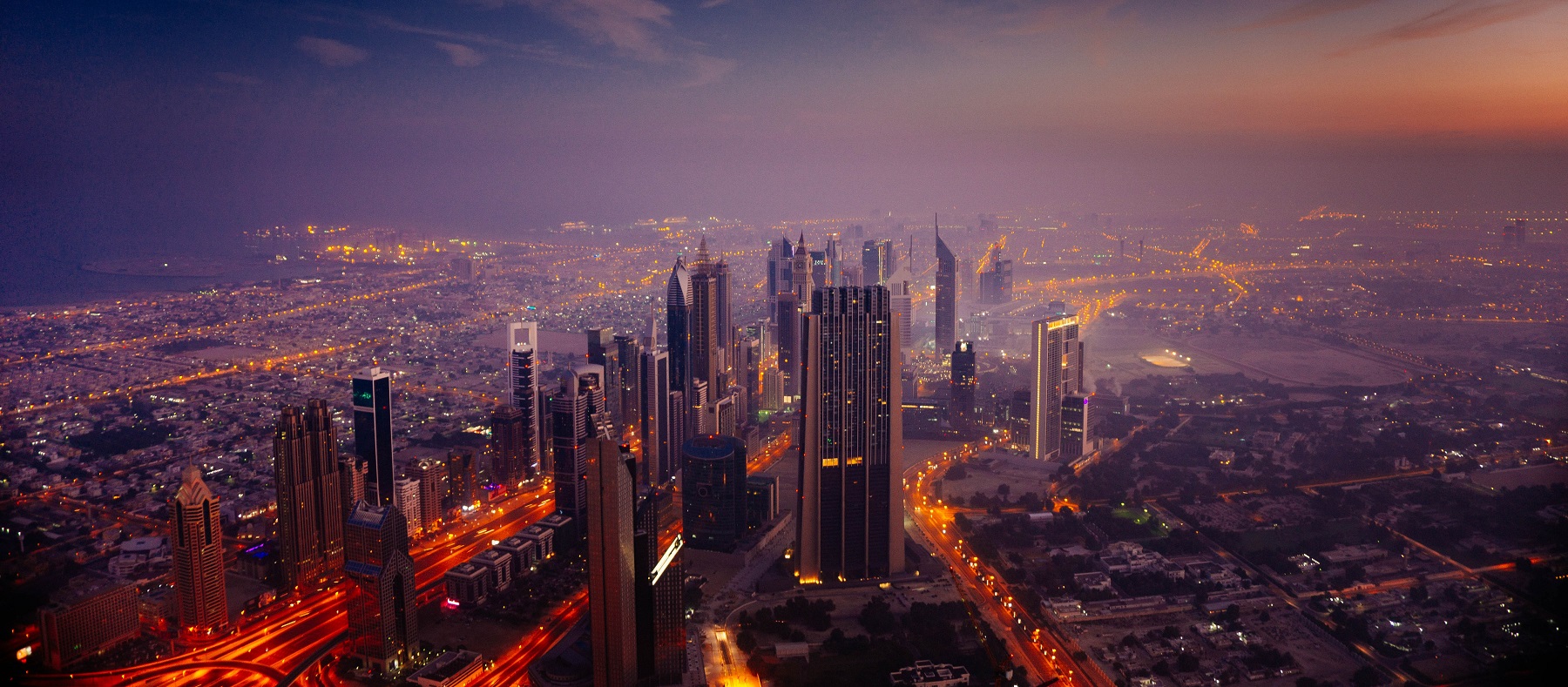
Dubai is an impressive sight already from the air before landing at one of the city’s airports. Along the water and in other neighborhoods of the city, skyscrapers stand in contrast to the flat desert landscape surrounding the modern and rapidly expanding city, the largest in the United Arab Emirates.
The top of Dubai is literally up in the clouds with Burj Khalifa’s almost 830 meters/2,725 feet in height. The high-rise was completed in 2010 as the world’s tallest, and Dubai has in several other ways marked itself with the first, largest and most impressive things in different fields.
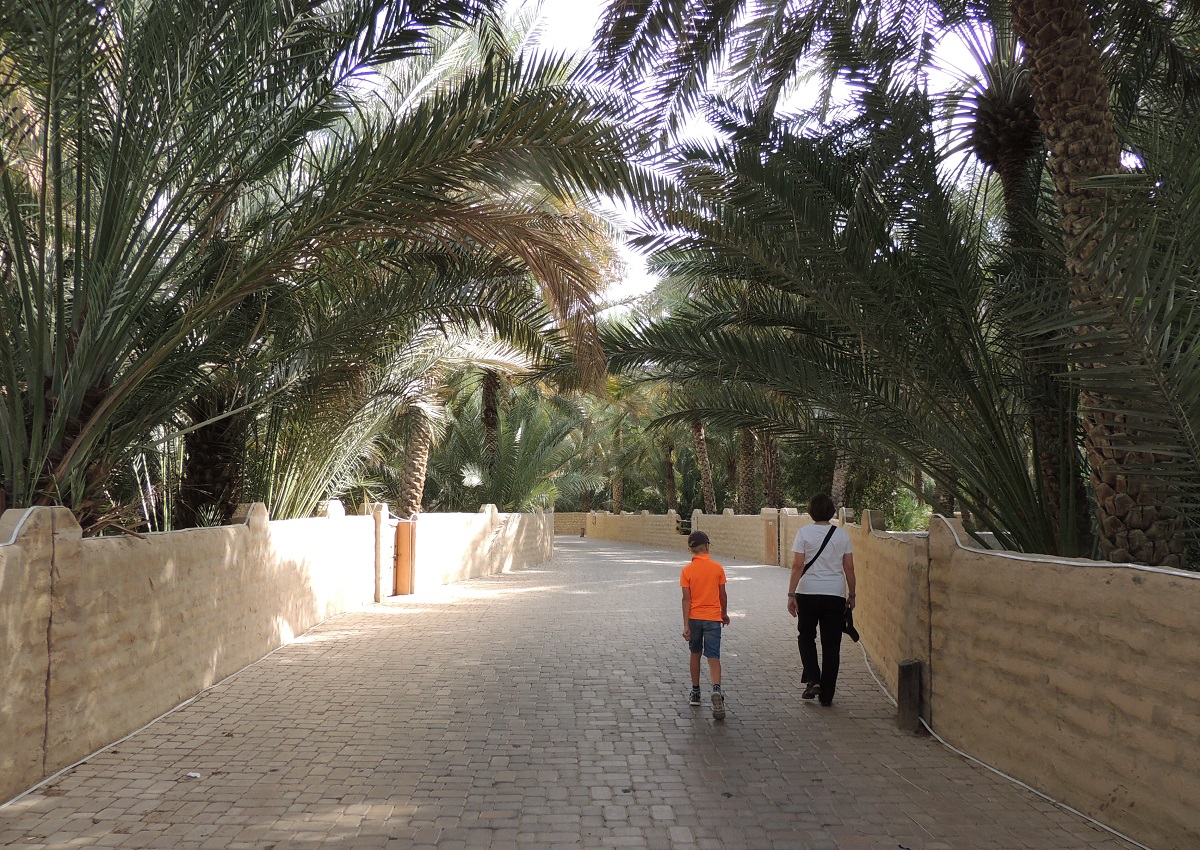
Al Ain is the largest city in the interior of the United Arab Emirates and it is the second largest city in the emirate of Abu Dhabi. The city is located in the desert as an oasis and on the border of Oman and the city of Al-Buraimi, and there are believed to have been settlements here for almost 8,000 years.
The development of modern Al Ain started with the emirate’s independence in 1971. As part of Abu Dhabi, many investments came to the city, which experienced rapid growth. In 1972, the border with Oman was established, and since then the city has grown significantly.
Al Ain has a dry desert climate, which is why the city is a popular excursion destination for many from Dubai and Abu Dhabi, and the city has developed into a tourist destination with many exciting sights. Al Ain is known as the Garden City, which is not least due to its famous oasis, which is included in UNESCO’s World Heritage List.
The oasis is a fantastic place where you can walk in large palm forests. It is known for its underground irrigation system, which brings water from boreholes to small irrigation canals that lead to the palm trees of the oasis. The irrigation is an ancient system that dates back thousands of years and is widely used in both the Emirates and other countries in the region.
Close to the oasis, you can visit the Al Ain Museum, where you can see ethnographic and archaeological exhibits depicting different aspects of the country, focusing on the area around Al Ain. The collections include, among other things, finds from the Bronze Age tombs at Mezyad and archaeological parks on the outskirts of the city.
It is also worth visiting the Sheikh Zayed Palace Museum, which is housed in the former residence of Sheikh Zayed Bin Sultan Al Nahyan, who lived here until 1966. The palace was built in 1937 in a fort-like style and has exciting collections of various effects and themes here.
There are also several forts in the city such as Qasr Al Muwaiji, which was built in the early 1900s by Sheikh Khalifa bin Zayed bin Khalifa Al Nahyan, and it opened as a museum in 2015. You can also visit Al Jahili Fort, which is an impressive building from the end of the 19th century, where it had to protect the palm farms in the local oasis.
Sharjah is an emirate located immediately east of Dubai with only a few kilometers to the center of the city of Sharjah. It is the third largest emirate in the country, and Sharjah as a city is also the country’s third largest after Dubai and Abu Dhabi.
Sharjah was historically one of the area’s prosperous cities, and in 1727 it declared itself independent. Later, Sharjah entered into a treaty with Great Britain in the same way as the emirate’s neighboring states. In 1971, Sharjah formed the United Arab Emirates together with the neighboring states, and today they are the same country, but with clear differences between the individual emirates.
Today there is much to see in the city of Sharjah such as Al Hisn, also known as Sharjah Fort. It was a fortified complex built in 1823 as the headquarters of the then independent emirate and as the residence of the Al Qasimi family. The fort is located in the center of the city, and it is now set up as a museum.
There are also other museums in the city such as the Sharjah Art Museum and the Al Mahatta Museum, which is an aviation museum that depicts the history of aviation in Sharjah and the emirates. The museum is located in the so-called Mahatta Fort, which was built as the then airport for Imperial Airways for flights and stops in the city.
One should also take a walk in the old part of Sharjah, which is located near the city’s fort. Here you can see many low buildings and atmospheric souks such as Al Arsah. In the historic quarter, you can also visit the Sharjah Heritage Museum with historical exhibits and see the beautiful house, Bait Al Naboodah, which was built around the year 1845.
You can of course also see the modern parts of Sharjah with many activities and hotels, which are located along the Persian Gulf. You can also see the emirate’s largest mosque, the Sharjah Mosque, located southeast of the city itself. The Great Mosque is an impressive building that was inaugurated in 2019.
10th Street
abudhabi-mall.com
18th Street
marinamall.ae
Yas Island
yasmall.ae
Al Raha District
al-rahamall.com
Al Shahama Road
deerfieldsmall.com
Hamdan Bin Mohammed Street
Warner Bros. World
Al Falah Road, Yas Island
wbworldabudhabi.com
Yas Waterworld
Yas Leisure Drive, Yas Island
yaswaterworld.com
Ferrari World
Yas Leisure Drive, Yas Island
ferrariworldabudhabi.com
Emirates Park Zoo
12th Street
emiratesparkzooandresort.com
Marina Eye
Corniche Breakwater, Marina Mall
300 Observation Deck
Tower 2, Etihad Towers, West Corniche
jumeirah.com
The Arabian Peninsula is, with large desert areas, an often inhospitable place to live. Over time, Bedouins have settled on freshwater oases and developed village communities in these places. One of the larger oasis areas was located at Liwa inland of what is today the United Arab Emirates.
Abu Dhabi’s history began in the late 18th century, when the Al Bu Falah branch of the Bani Yas Bedouin from the Liwa Oasis just settled on the island of Abu Dhabi on the Persian Gulf. The reason was that freshwater resources had been found here. They migrated in 1793, and one of the migrant families was the leader Al Nahyan, who remains the ruler of the emirate today.
Abu Dhabi became one of the places where pearl trade was carried out along the Persian Gulf. The gulf was reportedly the best place for pearl fishing, and local fishing made several dives a day without modern aids. The divers were paid a share of the revenue for a whole season, and this life and trade was the hallmark of early Abu Dhabi.
The waters around the Arabian Peninsula were called the Pirate Coast in the 19th century due to an extensive piracy that took place against not least ships between Europe and Asia. Britain had great and valuable interests to protect with the colony of India and the traffic between Indian and British ports.
To counter the ravages of pirates, the United Kingdom signed a series of treaties with leaders of Arab states along the Persian Gulf, thus becoming the British sphere of interest as a protectorate of 1892. It managed to minimize the pirates’ attacks and thereby protect their voyages. However, British interest developed strategically with 20th century oil discoveries in the region.
Pearl fishing and pearl trade accounted for a portion of Abu Dhabi’s revenue and activities throughout the 19th century and early 1900s, when over 4,000 boats were active along the coasts. However, the previously so lucrative trade declined markedly from the 1930s, when international interest in the region’s oil resources increased significantly.
In 1936, sheik Shakhbut bin Sultan al Nahyan signed an agreement with the company Petroleum Development (Trucial Coast) Ltd. on the right to oil exploration in Abu Dhabi. This first agreement was followed in 1939 by a 75-year concession agreement. The agreement was for land exploration.
Offshore exploration also became more important and possible over the years, and in 1953 British Petroleum Exploration Company, D’Arcy Exploration Company, signed an offshore agreement. A few years later, the first oil was found in the Emirates, and in 1960 production started from the Murban-3 plant, the first onshore oil production. However, drilling continued and a 112 kilometer long pipeline was constructed before the first oil was exported. It happened on December 14, 1963, when the first tanker sailed from new oil port facilities in Jebel Dhanna.
Oil was produced in Abu Dhabi from the early 1960s, and that event helped the leaders of Emirates along the southern Persian Gulf discuss a union. Sheik Zayed bin Sultan al Nahyan became the head of the Emirate of Abu Dhabi in 1966, and he became a driving force in the following years association with the United Arab Emirates.
In the mid-1960s, the seven so-called TRUCIAL SHEIKHDOMS, Bahrain and Qatar were under British patronage, giving the small states political and military protection. In 1966, a debate began in the British government and the lower house that Britain could no longer protect the protectorates along the Persian Gulf. The British economy and other tasks of the British military around the world were reasons for the debate. It ended in 1968 with a declaration that Britain would withdraw from the states.
Sheik Zayed bin Sultan al Nahyan offered to pay all costs for the British military presence in the Emirates, but this was refused. Instead, the nine British protectorates sought to form a federation, which was first proposed in February 1968 following a meeting between the leaders of Abu Dhabi and Dubai. The two states had agreed on the framework for a union and the other Gulf states were invited to join the federation. All nine states initially agreed to a union, but due to political and practical disagreements, Bahrain became independent in August 1971, and Qatar followed Bahrain as an independent nation the following month.
The agreement with Britain expired on December 1, 1971, and from that date the seven emirates were independent states. Ajman, Fujairah, Sharjah and Umm Al Quwain immediately decided to join Abu Dhabi and Dubai, and Ras al-Khaimah became part of the union in early 1972. Abu Dhabi was the capital of the new country and Abu Dhabi leader became President of the Union State.
Oil recovery continued to increase with the discovery of new oil fields. In 1971, sheik Zayed bin Sultan al Nahyan established the company ADNOC, the Abu Dhabi National Oil Company, which has since played a tremendous role in the development of Abu Dhabi.
From the 1970s, Abu Dhabi’s economy was increasingly driven by oil revenues, which offered the opportunity to completely rebuild the capital. Hotels, office buildings and apartment complexes were built over the following decades and Abu Dhabi developed into a modern metropolis.
In the United Arab Emirates, it was a period neighboring Dubai that became world-renowned for new buildings, shopping malls and much more that should move the emirate’s economy from oil to tourism and the service industry. Abu Dhabi followed suit and is currently undertaking huge development projects of infrastructure, neighborhoods and cultural and entertainment services.
Now it is very clear to all visitors that Abu Dhabi has evolved tremendously over the past few decades. Countless skyscrapers, internationally designed museums with the Louvre Abu Dhabi at the forefront, major shopping malls and theme parks such as Ferrari World are some of what many tourists experience.
Alongside all the new construction following the impact of oil revenues on the economy, one can glimpse the history and culture of the city through, among other things, all the Nahyan family’s 18th-century fort and traditional dhow boats. The contrasts from new to old are great and that is some of the fascination about Abu Dhabi.

Abu Dhabi, United Arab Emirates
Overview of Abu Dhabi
Abu Dhabi is the capital of the United Arab Emirates and beautifully located on the coast along the Persian Gulf. The city is characterized by the opportunities that come from the country’s huge oil revenues, and the many modern buildings, museums and activities can do nothing but impress tourists.
Abu Dhabi is a city where ancient culture meets the modern world. From the cultural Heritage Village, where the time has gone back to life before the oil economy, you can see the city’s skyline and majestic skyscrapers as a contrast.
About the Whitehorse travel guide
Contents: Tours in the city + tours in the surrounding area
Published: Released soon
Author: Stig Albeck
Publisher: Vamados.com
Language: English
About the travel guide
The Whitehorse travel guide gives you an overview of the sights and activities of the Canadian city. Read about top sights and other sights, and get a tour guide with tour suggestions and detailed descriptions of all the city’s most important churches, monuments, mansions, museums, etc.
Whitehorse is waiting for you, and at vamados.com you can also find cheap flights and great deals on hotels for your trip. You just select your travel dates and then you get flight and accommodation suggestions in and around the city.
Read more about Whitehorse and Canada
Canada Travel Guide: https://vamados.com/canada
City tourism: https://visitwhite-horse.ca
Main Page: https://www.vamados.com/
Buy the travel guide
Click the “Add to Cart” button to purchase the travel guide. After that you will come to the payment, where you enter the purchase and payment information. Upon payment of the travel guide, you will immediately receive a receipt with a link to download your purchase. You can download the travel guide immediately or use the download link in the email later.
Use the travel guide
When you buy the travel guide to Whitehorse you get the book online so you can have it on your phone, tablet or computer – and of course you can choose to print it. Use the maps and tour suggestions and you will have a good and content-rich journey.


Heritage Village is a reconstructed city in Abu Dhabi, located as an open-air museum, where you get a good impression of the time before the United Arab Emirates’ oil revenues changed the country to what you can see today. It is a unique opportunity in the emirates, which otherwise stand as modern cities after a colossal development in a few decades.
You can thus experience the traditional lifestyle in the desert in the Heritage Village, where you can visit, among other things, an old-fashioned souk, a mosque and a camp modeled after the historical life of the country. There are also working workshops with artisans making ceramics, blowing glass and weaving fabric.
Emirates Palace is the name of a five-star hotel in a particularly beautiful location, which is one of Abu Dhabi’s best-known buildings. The hotel was built in the years 2001-2005 and it opened with 394 rooms and suites.
The luxury hotel is situated like a sumptuous castle next to the Persian Gulf. The hotel’s design blends Islamic architectural elements such as balance and geometry with modern design and construction. The hotel’s color is inspired by the desert sands of the state, and around it are beautiful green plants.

Dhow Harbour & Fish Market is an atmospheric place in Abu Dhabi’s harbor area. Here you will find, among other things, Dhow Harbour, which is home to many of the traditional dhow boats that have plied the waters along the current emirates and large parts of the region for centuries.
Today, the harbor is a lively fishing harbor where you can see and experience the atmosphere, and you can also visit the Fish Market, which is both a fish market and a place with many places to eat. Here you can have fresh fish prepared and enjoy it at the many traders’ eateries.

Sheikh Zayed Bridge is a bridge that is often passed in Abu Dhabi. The city center is on an island, and many other parts of the city’s neighborhoods are on other islands. Therefore, it is natural that there are many bridges here.
Probably the most noteworthy of the bridges to and from Abu Dhabi is the Sheikh Zayed Bridge, which was designed by the British architect Zaha Hadid. The 842 meter long and 64 meter high bridge is shaped like rolling dunes with a dynamic lighting design with subtle floating colours.
Ferrari World is a primarily indoor theme park in Abu Dhabi, and it is the first in the world with a Ferrari theme. And the theme is pervasive in many of the attractions you can experience under the red Ferrari roof that covers the place.
Construction started in 2007, and Ferrari World opened in 2010. Since then, several new rides have been established, and perhaps the best known is Formula Rosso. Formula Rosso is a roller coaster with a length of over two kilometers and a top speed of 240 km/h.

Corniche Road or simply The Corniche is an approximately eight kilometer long road in Abu Dhabi that lies breathtakingly along the Persian Gulf. The stretch is a popular place for a stroll, a bike ride or to go to the beach or use the playgrounds along the way.
The Corniche was built on reclaimed land, and decades ago there were sandy beaches here and dhows anchored and brought goods to and from shore. It is history, and today Corniche Road is a fashionable street with fantastic views over the water.
The UAE Flagpole is a 122 meter high flagpole that can be seen in many places in Abu Dhabi. It is a flagpole that was erected as the world’s tallest in 2001 near the Marina Mall.
Today, there are several flagpoles around the world that are taller, but there are few that are as breathtaking as the UAE Flagpole. The flagpole stands with water on three sides, and from it you can enjoy a panoramic view of the Abu Dhabi skyline.
Capital Gate is a high-rise building that can also be called the Leaning Tower in Abu Dhabi. The skyscraper over 160 meters tall spread over 35 floors and was designed to lean 18° to the west. The building was erected on 30 meter deep piles to ensure stability.
The slope is over four times greater than that of the Leaning Tower of Pisa, but unlike the Italian tower, the skyscraper in Abu Dhabi was built with the slope. The house stands on an approach road and has been a distinctive architectural feature in the city since 2011.
The Aldar HQ Building is one of Abu Dhabi’s most distinctive buildings with its circular shape. It is, so to speak, an aesthetically beautiful round building that stands along one of the eastern approaches to the central island of Abu Dhabi.
The building was completed in 2010 with a height of 121 meters with 23 floors. The round high-rise was named after the developer, Aldar Properties, and the construction is elegant, with the concept largely eliminating the need for interior columns.
Similar to Abu Dhabi Travel Guide
